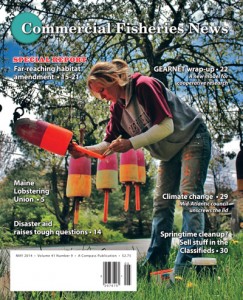The latest butterfish stock assessment is a game changer, not just for the long-finned (Loligo) squid fishery, which has been stymied by a butterfish bycatch cap, but for the way some stock assessments could be conducted in the future.
Published in late March, the assessment found that no overfishing was occurring. In fact, scientists then determined that the stock could support a 35,000 metric ton (mt) allowable biological cap (ABC), a stunning turnaround considering that the ABC in 2010 was
1,500 mt.
 So are there more butterfish in the ocean than before? Probably not. Instead, the authors of the assessment summary said that the use of new information from research studies “led to improved understandings of the population dynamics.”
So are there more butterfish in the ocean than before? Probably not. Instead, the authors of the assessment summary said that the use of new information from research studies “led to improved understandings of the population dynamics.”
Those studies were the product of a unique approach to research pioneered by a group of federal and academic scientists and industry members.
Back in 2011, John Manderson, a scientist with the National Marine Fisheries Service (NMFS), and Greg DiDomenico, executive director of the Garden State Seafood Association, organized a collaborative research project to jointly create a butterfish bycatch model in hopes of helping Loligo fishermen avoid butterfish.
They set up what they called a “Butterfish Smackdown,” putting scientists and fishermen into separate groups during a series of workshops to work
on butterfish models and then getting them back together to compare notes. The fishermen’s group concluded that temperature was one of the most important indicators of where to find butterfish.
While there was a lot more to it, basically both groups agreed to blend their approaches with a focus on identifying butterfish habitat based on temperature. From those beginnings, the Butterfish Working Group was born.
Manderson and Point Judith fisherman Chris Roebuck, aided by teams of other researchers who contributed ocean current and temperature data, tested the model during the winter of 2012. As part of this, Roebuck made tows at times and in areas where he knew from experience that butterfish would be. Roebuck reportedly surprised all involved by “filling the boat with butterfish.”
All of this and follow-up research suggested that the NMFS trawl survey, which is conducted at fixed times in pre-selected areas, had routinely missed butterfish. And it demonstrated the need to take environmental data into account when trying to determine butterfish location and gauge stock abundance, especially in the absence of commercial fishery landings, which had been restricted for years by regulations.
The results generated through the new model were incorporated into the latest stock assessment and used to adjust estimates of butterfish abundance based on the amount of habitat sampled. The benefits already are being realized through increased butterfish quota and trip limits for 2014 with further expansion of the fishery possible in the future.
Perhaps even more importantly, the scientists involved in this collaborative effort came away with a heightened sense of respect for fishermen’s knowledge, while participating fishermen were encouraged by scientists’ willingness to drop long-held assumptions and try a different way. By working together, they developed a vastly improved approach for estimating stock abundance, not only for butterfish but also for other species where temperature is a driving habitat factor.
That’s a promising step forward. /cfn/
 Read the rest and much, much more in the May issue of Commercial Fisheries News.
Read the rest and much, much more in the May issue of Commercial Fisheries News.
Read online immediately and download for future reference.








 Updating...
Updating...